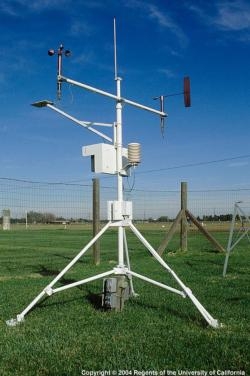Since the drought of the late 1970's, the University of California researchers, UCCE San Joaquin Master Gardeners and many others have compiled an arsenal of resources and tools to help the California gardener cope with a Mediterrean climate and all too-frequent droughts. But studying this material can also be like drinking from a firehose, unless you know where to start. Here is a “rain chain” of ideas to help learn in small sips.
Keep it simple! In a recent conversation with Karrie Reid, UCCE Area Environmental Horticultural Advisor, we discussed the current lack of rain and warmer temperatures, as compared to years past, as well as strategies for good gardening. Her quick summary was, “there is no normal weather or rainfall anymore here in California.” We must adapt to the current seasonal challenges, and tend our landscapes and lawns with prudence. Here are a few of the simple tips she offered for managing a garden during this dry winter season.
- Study CIMIS data for rainfall and ET? in your area: San Joaquin County has five different California Irrigation Management Information System, or CIMIS, weather stations in the county, including Manteca, Staten Island, Holt, Ripon, and Linden. Each of these stations are measuring and gathering a data set of information to estimate the evapotranspiration rates for a patch of grass at the station (that's a measurement of the amount of water used). Rainfall is also being measured.

Karrie started our search for CIMIS information using the Ripon weather station data, and learned that the month of November, 2020, ET? rate was 2.19 inches, and the rainfall was .14 inches. Simply put, more water was used by the grass than was replaced by rainfall. Bottom line: we needed to irrigate lawns and even moderate and low-water shrubs and perennials in a month that would normally supply that with rain.
- Water deeply, occasionally - To remedy this dry season, water only the plants which are still using water. Dormant, deciduous plants do not use water this time of year. Water landscape plants deeply, but only occasionally.
- Water before frosts or high winds- If frost or high winds are expected, be sure your garden is watered, and not dry. A well-watered plant is buffered and protected from winds and frost.
- Prune after frost, not before- Speaking of frost, wait till after danger of frost has passed before you prune your landscape plants or trees. New growth will be damaged if a sudden frost snap drops temperatures.
- Lawn Watering Guide- Karrie also helped the City of Lodi create the Lawn Garden Watering Guide which is available on the City's Watershed Friendly website. You will need to adjust watering rates based on how much rainfall has fallen for the month; you will also need to know what kind of grass you have in your lawn.
- Warm or Cool Season Grass Water Needs- UC Publication 8044, will help you evaluate your landscape needs and adjust timers. As Karrie likes to say, “Too much or too little water on lawns makes for unhealthy grass.”
- Easy Steps to Setting Your Landscape Controller and Water Usage of Common Landscape Plants This handout is a gem for figuring out how to use your landscape controller, as well as understanding water usage for common plants and our lawns.
- Trees Need Water, too- Estimating Tree Requirements- UCCE's Center for Urban and Landscape Horticultureis a treasure trove of information that will help the home gardener sort out his particular landscape needs. Loren Oki's and Dave Fujino's tree ring contraptionoffer a simple, efficient system to water your trees slowly and deeply.
- Plant a Water Wise Garden- SJC Master Gardeners- Low Water Landscapes October through March is an ideal time to plant new landscape plants. Be sure to keep new plants well-watered until they are established.
- “Catch Rain Where Rain Falls”- Harvest the Rain! Divert Your Downspouts to the lawn- As Brad Lancaster, author of the book, “Rainwater Harvesting for Drylands and Beyond”, Volume 1, points out, the “small-scale strategies are the most effective and the least expensive…and the benefits are many.” Catch more rainwater where it falls by diverting your downspouts to the garden, away from your house foundation. Remember, rainwater is still nature's free gift!
